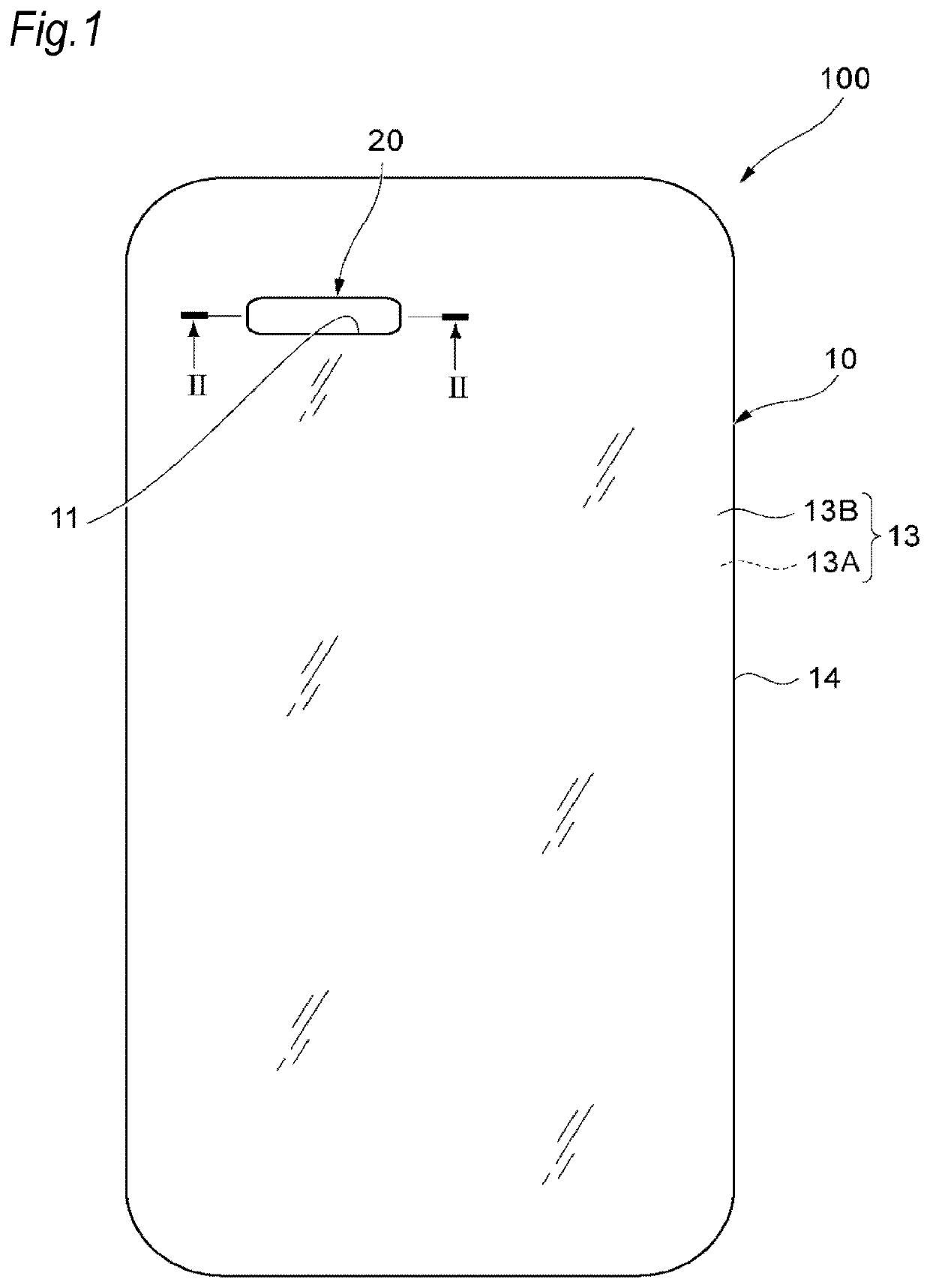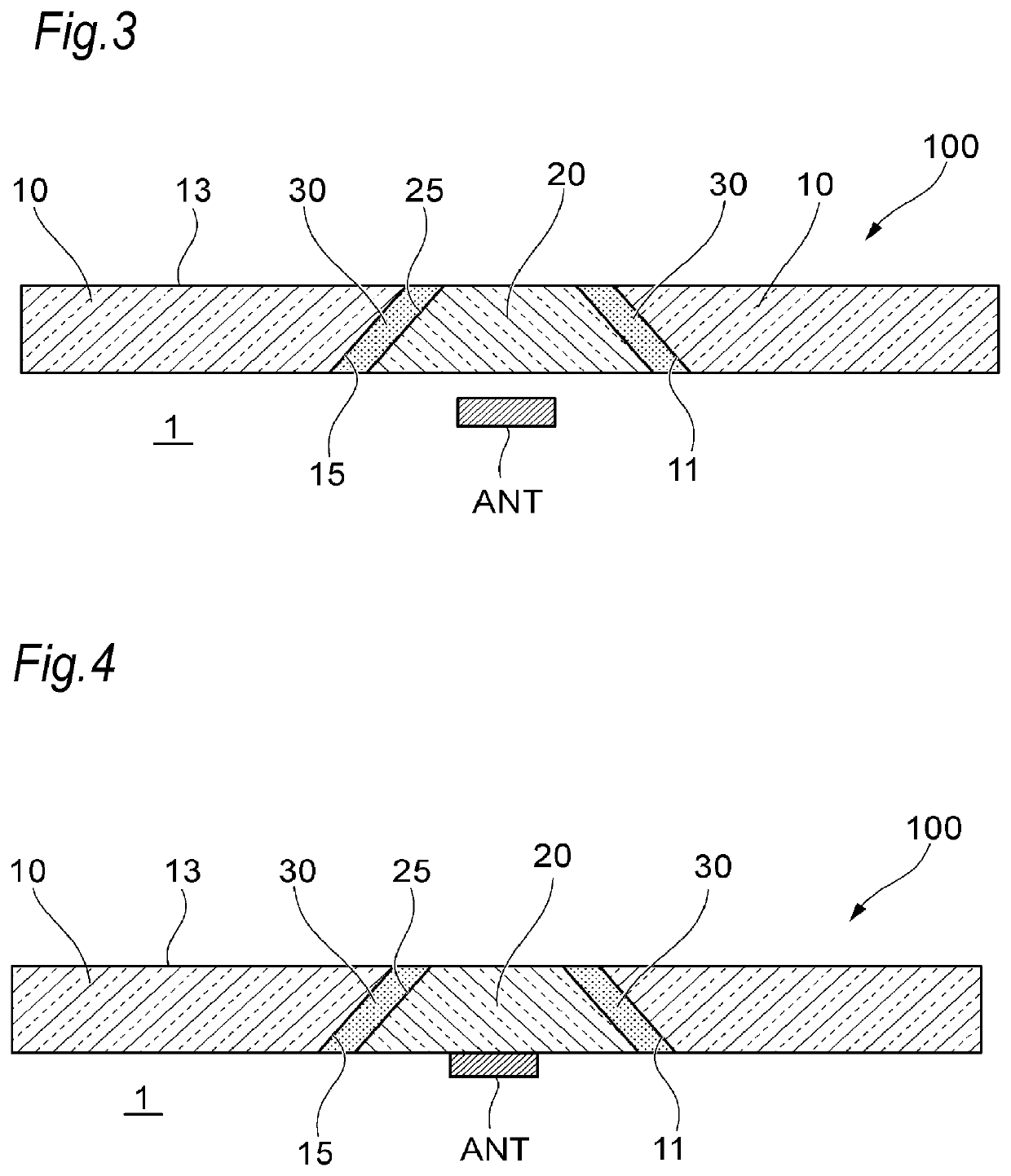Protective member and communication terminal device including the same
a technology of communication terminal and protective member, which is applied in the direction of disturbance protection, substation equipment, protection of radiating elements, etc., can solve the problems of difficult to increase radio wave permeability, high dielectric loss tangent, and large dielectric loss, so as to reduce radio wave propagation loss, and good communication
- Summary
- Abstract
- Description
- Claims
- Application Information
AI Technical Summary
Benefits of technology
Problems solved by technology
Method used
Image
Examples
second embodiment
[0065]In the protective member 100 of the first embodiment, the hole 11 penetrating front and back of the first base material is formed in the first base material 10, and the second base material 20 is attached by fitting it in the hole 11, but the configuration of attaching the second base material 20 to the first base material 10 is not limited to the fitting in the hole 11 penetrating front and back of the first base material.
[0066]FIG. 8 is a cross-sectional view of a protective member 100 where a second base material 20 is fitted in a hole (recess) 17 that is formed in a first base material 10 and recessed in the thickness direction of the first base material. FIG. 9 is a cross-sectional view of a protective member, illustrating an arrangement of an antenna ANT in a protective member 100 where a second base material 20 is fitted in the hole (recess) 17 that is formed in the first base material 10 and recessed in the thickness direction of the first base material.
[0067]As illust...
third embodiment
[0069]FIGS. 10A and 10B are schematic front views of Modification Examples, illustrating other arrangement examples of the second base material 20 in a protective member. Here, with respect to the protective member 100 illustrated in FIGS. 10A and 10B, the shape (aspect ratio, etc.) thereof is schematically depicted.
[0070]As illustrated in FIG. 10A, for example, in the case of providing the protective member 100 on the side (front side) where the display portion of the protection target 1 is arranged, the second base material 20 may be arranged in a non-display region 5 outside the display portion 3. The non-display region 5 is an opaque region where a print layer, etc. is formed on the protective member 100. The second base material 20 has a print layer, etc. and is arranged in this non-display region 5, and the second base material 20 is thereby intentionally arranged to stand out distinctly.
[0071]Also, as illustrated in FIG. 10B, in the case of providing the protective member 100...
fourth embodiment
[Fourth Embodiment] (Step Between First Base Material and Second Base Material)
[0073]As illustrated in FIG. 2, in the case of providing the protective member 100 to cover the display portion on the front surface side of the protection target 1, a step between the outer-side surface 13B of the first base material 10 and the outer-side surface 23B of the second base material 20 in the thickness direction of the first base material is set to preferably 10 μm or less, more preferably 3 μm or less, still more preferably 1 μm or less. In order to reduce the step, after the first base material 10 and the second base material 20 are bonded, the surface may be polished and made flat.
[0074]According to this configuration, the visibility of the display portion is not reduced. Also, since the step is small, the tactile sensation or operability in a touch panel is not impaired.
[0075]On the other hand, in the case of a protective member 100 covering the rear surface side where the display portion...
PUM
| Property | Measurement | Unit |
|---|---|---|
| Thickness | aaaaa | aaaaa |
| Thickness | aaaaa | aaaaa |
| Angle | aaaaa | aaaaa |
Abstract
Description
Claims
Application Information
 Login to View More
Login to View More - R&D
- Intellectual Property
- Life Sciences
- Materials
- Tech Scout
- Unparalleled Data Quality
- Higher Quality Content
- 60% Fewer Hallucinations
Browse by: Latest US Patents, China's latest patents, Technical Efficacy Thesaurus, Application Domain, Technology Topic, Popular Technical Reports.
© 2025 PatSnap. All rights reserved.Legal|Privacy policy|Modern Slavery Act Transparency Statement|Sitemap|About US| Contact US: help@patsnap.com



